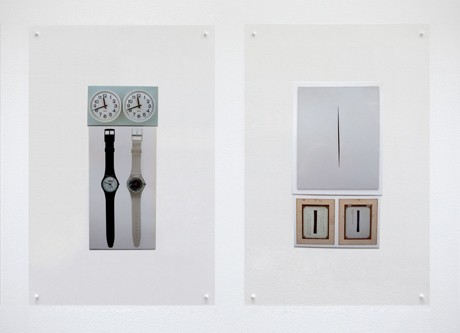Luis Jacob: A Response to Ellen Feiss' "A Locally Bound Materialism"

Luis Jacob, Album XI, 2013. Courtesy of the artist and Galerie Max Mayer, Düsseldorf and Birch Contemporary, Toronto
It is with great interest that I read Ellen Feiss’s online article, “A Locally Bound Materialism,” about my recent exhibition at WORK Gallery, London. I write this text with the hope of adding nuance to Feiss’s interpretations of my work, which, in part, takes as its starting point her interest in the power of digital images that circulate online.
According to her, my work “cannot account for the role of the digital image and its circulation on the internet”. While I should be clear that it has not been my intention in this exhibition to account for the role of digital images,I shall try to trace the line of argument in her article which I believe is distorted by a technological bias.
Feiss mainly focuses her inquiry on Album XI, and asks whether this work takes account of the online circulation of digital imagery. According to her, this work demonstrates the centrality of digital images, but it does so precisely by what she calls the “gaping absence” of the digital realm within the work. What renders Album XI as an inadequate account of digital images, according to Feiss, is the fact that its own imagery is derived from print, not online sources: “An image taken from print circulation cannot access the primacy of the digital image today, as it is their circulation and movement online that makes them ‘actants’.”
This is the place where a technological bias weakens her argument, making it questionable both at the level of theory as well as practice. Feiss’s use of the technical term actant alludes to the theoretical work of writers like Bruno Latour and Graham Harman, who describe objects – including what we may call image-objects – as actants that derive their agency from successfully connecting themselves to other actants. It seems to me that what matters is less the kind of networks that connect actants (that is, whether these networks are digital or not), than the sheer quantity of connections which actants are able to establish and sustain within their networks. The Internet is thus simply one network out of many other existing networks; there is nothing inherent in digital images that would guarantee them a preeminent ability to establish more powerful connections in the world today.
In addition, there are practical factors to consider. Even if we concede that digital networks play a special (even primary) role in the world today, it is not at all obvious that an image-object must be digital for it to be able to establish online networks, and enhance its agency there.
At this point, it might be useful to adopt the lessons of Latour’s Actor-Network Theory in order to describe the actual migration of the images of Album XI from printed publications to digital platforms. What are the actual practices that lead to their circulation? Given the prevailing social protocols within the network of actors that we call the art-world, I wonder about the likelihood of exhibiting Album XI in London, had this work existed exclusively in digital form. Would Feiss have felt compelled to write about the Album and would Texte zur Kunst have agreed to publish her text, if the Album had existed exclusively in the form of a Tumblr blog, for example, and not a gallery exhibition? These are speculative questions, of course. My point is that an assemblage of print images, which I cut out of books and magazines in my studio on Cawthra Street in Toronto, did migrate into a relatively powerful online network of the international art-world. Their quality as print material did not inhibit their circulation in digital, online networks. Proof of this claim appears as the illustrations of Ellen Feiss’s article on the Texte zur Kunst website.
Her observations about the importance of location in my work already provide important conceptual tools for describing the actual paths that image-objects forge in the world. My considerations here are offered as an effort to enhance the ideas presented in her article. I hope it is clear that if I take issue with certain claims in her text, it is because I believe in the fundamental value of both Feiss’s own ideas and her engagement with my work, for which I remain grateful.
Luis Jacob
